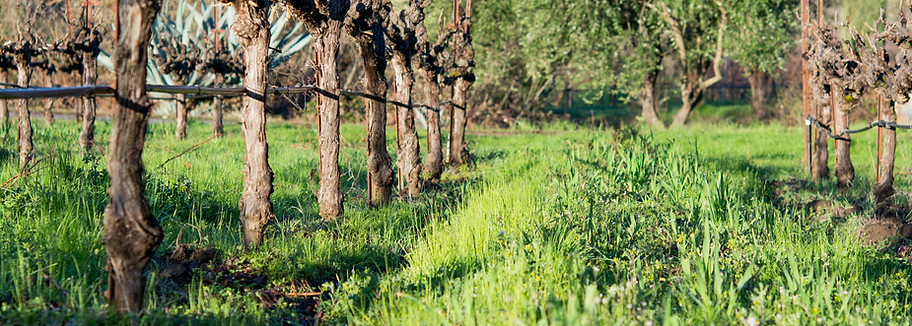IMPLEMENT: SOIL HEALTH & CARBON SEQUESTRATION
Healthy Soils are Essential for Vineyard Adaptation and Mitigation
Maintaining and enhancing soil health is one of the most effective strategies for adapting to climate change impacts and addressing mitigation in a vineyard.
-
Adaptation: Healthy soils can help address drought, excess precipitation and extreme heat. Management practices that increase organic matter, enhance soil structure, and reduce soil disturbance, especially during high rainfall events, can improve water availability and promote water storage and infiltration.
-
Mitigation: Healthy soils sequester and store more atmospheric carbon. Soil amendments - including compost, biochar, and mulch - can help increase and retain soil organic carbon, and cover crops can also increase soil organic carbon.
An added benefit to these climate smart practices is increased soil fertility, which improves plant health and resiliency to pests and disease pressure. The many benefits to healthy soils are the key reason it is an important part of any sustainable, regenerative, organic or biodynamic winegrowing approach.
Priority Practices Quick Links:
Carbon Sequestration: The capture and long-term storage of carbon dioxide (CO2) in plant material and soils. Plants are considered a “sink” for CO2 because they uptake CO2 during photosynthesis and store it in plant tissue such as leaves, wood, and roots. The burning of vines can release some of this carbon back into the atmosphere. Chipping and low smoke burning techniques used to produce biochar can significantly reduce these carbon loses.
Optimizing Nitrogen is Vital to Reducing Vineyard GHG Emissions
An important source of vineyard GHG emissions is the use of nitrogen fertilizers. When any nitrogen is added to soil, some of the applied nitrogen can be converted to N2O. This can happen to any nitrogen-containing additive including synthetic fertilizers (e.g. nitrate and ammonium) and organic materials (e.g. green manures and pomace). All N2O production associated with vineyards results from soil microbes using the nitrogen instead of the vines. Providing just enough nitrogen that vines need and timing nitrogen applications to ensure maximum uptake by roots can decrease N2O emissions.
Cover Crops are a Powerful Tool for Adaptation and Mitigation
Cover crops can buffer the negative effects of extreme weather events — e.g., precipitation and flooding, along with heat waves. The use of cover crops can increase the storage of carbon in vineyard soils and decrease CO2 emissions. Perennial cover crops are most efficient at doing this because of their greater root production. In addition to increasing soil carbon, leguminous cover crops supply nitrogen to the soil, and may be used to decrease applications of synthetic fertilizers. Cover crops also decrease the offsite movement and loss of soil organic matter by erosion and nitrogen by leaching.

Soil Amendments Increase Water Storage
Soil amendments such as compost, mulch and biochar can increase soil organic matter, water storage capacity and nutrient cycling. Compost can improve soil structure and increase soil water storage, with the level of impact dependant on the compost characteristics and the number and rate of applications. Mulch is effective as both a soil cover, improving soil water storage, and a means of increasing soil organic matter. Biochar has many positive benefits including on water and nutrient retention, improved soil structure and carbon sequestration.
Reduced Tillage Helps with Mitigation and Adaptation
The act of tilling soil can consume substantial quantities of fossil fuel. By breaking up soil aggregates, tillage increases soil emissions of CO2 and N2O by mobilizing carbon and nitrogen, thus allowing microbes to access and consume previously protected organic matter. Each tillage pass causes some loss of soil-sequestered carbon. Decreases in tillage not only limit CO2 emissions but protects against the loss of organic matter through erosion which increases the soils ability to absorb excess precipitation.
Non-Crop Vegetation Carbon Sequestration Potential
Non-crop vegetation in and around vineyards such as buffer strips, hedgerows, natural woodlands, and riparian flora can also contribute to climate mitigation. The carbon stored in these woody long-lived perennial plants and the soil in these areas can represent a large source of sequestered carbon, significantly decreasing overall GHG emissions. Oak woodlands, for example, can store large amounts of above- and below-ground carbon over their lifetime. In addition, these areas can help reduce soil erosion and runoff, which helps in extreme weather events that are increasing due to climate change and increases carbon sequestration potential by keeping soil in place.
Sustainable, Regenerative, Organic and Biodynamic Farming are Climate Smart
Many of the soil health practices included in this toolkit will look familiar to growers who participate in certification programs for sustainable, regenerative, organic or biodynamic winegrape growing. All of these farming approaches include practices to build and maintain soil health, which has a direct impact on the ability of a vineyard to mitigate and adapt to climate change. To learn more about the relationship between sustainable and regenerative winegrowing, see the CSWA Sustainable and Regenerative Winegrowing Handout, which includes a list of regenerative winegrowing principles and examples of practices to help winegrape growers better understand and communicate about the relationship.

-
Soil Health & Carbon Sequestration Implementation Guide: The guide includes practices and resources for optimizing nitrogen, increasing organic matter, cover crops, carbon sequestration and erosion prevention.
-
Habitat & Biodiversity Implementation Guide: The guide outlines key practices and resources to support implementation of wildlife habitat such as hedgerows, buffer strips and nesting boxes, native woodlands and riparian and aquatic habitats.
